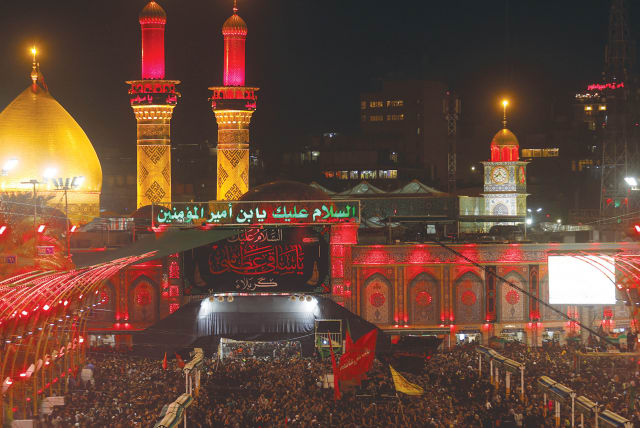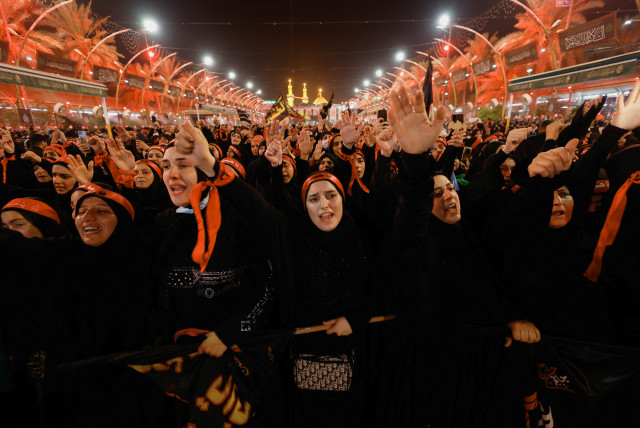A historic Iraqi city connects between past and future in a divided Middle East - opinion

The Battle of Karbala is not only history but a haunting reality. A marriage of medieval theology with Iran's attempt to produce nuclear weapons should alarm all people and leaders of the free world
The next president of the United States must be prepared to face the challenge of Karbala. While it is the name of a town today in Central Iraq, Karbala was the site of one of the most important battles in the history of Islam.
The history of Karbala
On the plain of the town, the forces of the Umayyad caliphate massacred fellow Muslims who supported the family of Ali ibn Abi Talib, Muhammad’s cousin and son-in-law, rivals to the Umayyads for power in the emerging Islamic world.
The death of Ali’s son Hussein at Karbala on October 10, 680, was the culmination of an almost 50-year struggle between Muslims to determine who would succeed Muhammad as the religious and political leader of the Islamic realm. While the events of Karbala are more than 1,300 years old, the massacre is an important key for world leaders today to understand the emergence of Iran as a nuclear power, as well as the terror of Hamas, Hezbollah, and the Houthis.
For most Muslims, especially those in the world of the Shia in Iran, Iraq, and Lebanon, the Battle of Karbala is not simply a historical event but a haunting reality. The Shia supporters of Ali never recovered from the defeat that allowed the Umayyad dynasty to control the territory, wealth, and population of one of the world’s largest empires. While the majority of Sunnis did not eradicate the followers of Ali and Hussein, the Shia were never given the respect and standing in the Islamic world that they believed they deserved. During certain eras of Islamic history, this tension broke out into violence, such as the attempt by the 18th-century Sunni Arabian reformer Muhammad ibn Abd al-Wahhab to stamp out Shia practices that included pilgrimages to holy sites such as Karbala. Even the major victory by the Shia in the early 16th century – the Iranian leader Shah Ismail’s successful and long-lasting imposition of Shi’ism on the Persian Safavid Empire – did not lead to Shia dominance in a world ruled by Sunnis.
Karbala as reflecting the modern Middle East
It would be at our peril, however, to simply view the events at Karbala as a historical phenomenon. As a result of Hussein’s defeat in 680, the Shia Muslims developed a theology that predicts the return of a descendant of Ali – the “Hidden Imam” – who will reassert leadership of the Islamic world as a true ruler from the family of Muhammad. The return will be accompanied by apocalyptic events that will shake the world to its core.
The theology of Karbala is a living reality for some Shia Muslims, especially the mullahs and the Revolutionary Guard who control Iran. The marriage of a medieval, quasi-messianic theology of apocalypse with Iran’s attempt to gain the technology to produce nuclear weapons should alarm all peoples of goodwill and the leaders of the free world. That includes America’s next president.
Karbala is not simply history for the religious leaders who control Iranian theocracy and for the Shia struggling for dominance in Iraq and Lebanon. It is the lens through which they view the world. It is folly to ignore this and to believe that diplomacy will dissuade the Iranian leadership from pursuing nuclear power.
While the military option will not likely be the way to persuade the Iranians from beating the drums of war and calling for the destruction of the “Zionist entity,” there are economic and even diplomatic weapons in the battle to isolate the Iranian leadership.
For those readers who are still skeptical of the power of the “Hidden Imam” theology to motivate the Shia in the Middle East to pursue their ambitions, I provide a warning with three examples. The first is the commemoration of Karbala on the holy day of Ashura.
On this most solemn day in the Shia calendar, Muslims in Iran, Iraq, and Lebanon, pour out their grief in an emotional day of mourning that sometimes includes the mourners beating themselves bloody with chains.
The events of Karbala are remembered in a “passion play” that retells the story of Hussein’s martyrdom and that of his infant son. Among the Shia on Ashura, emotions are intense, even exceeding the likes of the mourning of religious Jews on the Ninth of Av. Karbala is a living reality on Ashura. It is not simply a battle fought 1,300 years ago.
The second example is from the Khomeini Revolution in Iran a generation ago. Iranians supporting the Ayatollah identified the hated Shah with Yazid, the Umayyad caliph responsible for the death of Hussein at Karbala. The call to revolution was grounded in the theology of Karbala. The return of Khomeini was, for some, a harbinger of the return of the “Hidden Imam.”
For the revolutionaries in Iran, Karbala was – and remains – a living reality. Former Iranian President Ahmadinejad, during the Iran-Iraq war in the 1980s, trained teenage boys to march in front of the Iranian army and to step on land mines to clear the way for the Shia troops. For their martyrdom, these young men were promised a place in paradise.
Finally, if we in the West do not take Iran seriously, it is obvious that Sunnis in Saudi Arabia, Jordan, and Egypt are alarmed by the re-emergence of the Shia since the Iranian Revolution. The Arab world correctly perceives that the Iranian government wants to export its revolution and foment rebellion throughout the Muslim world in the Middle East. The rise of Hezbollah in Lebanon, Hamas in Gaza, and the Houthis in Yemen is indicative of Iran’s success in doing so.
The reality of Karbala in the nuclear age should wake this world up to the devastating impact of an apocalyptic theology that cannot be simply stifled through the formality of diplomatic negotiations. The Iran “deal” has resulted in the horrible events of October 7, 2023, and the reality that the mullahs will have a nuclear weapon in weeks, not months.
The writer is a rabbi, essayist, and lecturer living in West Palm Beach, Florida.
Jerusalem Post Store
`; document.getElementById("linkPremium").innerHTML = cont; var divWithLink = document.getElementById("premium-link"); if (divWithLink !== null && divWithLink !== 'undefined') { divWithLink.style.border = "solid 1px #cb0f3e"; divWithLink.style.textAlign = "center"; divWithLink.style.marginBottom = "15px"; divWithLink.style.marginTop = "15px"; divWithLink.style.width = "100%"; divWithLink.style.backgroundColor = "#122952"; divWithLink.style.color = "#ffffff"; divWithLink.style.lineHeight = "1.5"; } } (function (v, i) { });

